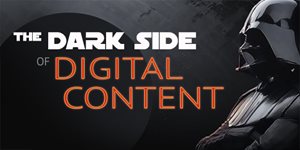6 Enterprise Tech Trend Predictions for 2018 and Beyond
2017 was the year of disruptive innovation and 2018 will be about combining those disruptive tech  innovations and putting them to work to fully experience their maximum business impact for enterprises. Taking into account the number of requests I received for a list of the enterprise tech trend predictions for 2018, I compiled six of the emerging trends that I believe will shape this year. This article will not only introduce potentially game-changing “new” technologies but also discuss what’s next with “now” technologies which have recently joined the established technology category.
innovations and putting them to work to fully experience their maximum business impact for enterprises. Taking into account the number of requests I received for a list of the enterprise tech trend predictions for 2018, I compiled six of the emerging trends that I believe will shape this year. This article will not only introduce potentially game-changing “new” technologies but also discuss what’s next with “now” technologies which have recently joined the established technology category.
Blockchain Will Continue To Evolve
Blockchain technology has been generating discussions since 2011, however, 2017 was the year when its real potential was unleashed. The reason behind this realization likely has so much to do with the drastic rise in the price of Bitcoin. What’s the next direction with this “now” technology? In 2018, blockchain will manage to spread outside of finance, including government, healthcare, manufacturing, media distribution, identity verification, title registry and supply chain.
real potential was unleashed. The reason behind this realization likely has so much to do with the drastic rise in the price of Bitcoin. What’s the next direction with this “now” technology? In 2018, blockchain will manage to spread outside of finance, including government, healthcare, manufacturing, media distribution, identity verification, title registry and supply chain.
In healthcare, for instance, IDC Health Insights predicts that 20% of organizations will have moved beyond pilot projects and will have operationalized blockchain by 2020. Speaking of vertical industries, the technology truly has huge potential to accelerate efficiency in the public sector. That being said, the initial point of bitcoin, for instance, was creating a tradeable currency which couldn’t be manipulated by governments. Therefore, it is hard to see how exactly this would play out but in 2018, we might see some governments adopting this technology as well.
In 2017, many capital ventures started hunting for companies that use blockchain technology in a creative and innovative way. In 2018, that exploration will come to fruition as we will see venture investors pouring big bucks into new cryptocurrency projects or blockchain startups. Good ideas are aplenty, however, because as Gartner agrees, many of the associated technologies will be immature for the next two to three years, blockchain investments may go through the same phase that artificial intelligence did. In the initial period of this technology taking off, we will witness some failed attempts that cause a costly waste of time.
Nevertheless, I believe, it will put us on the edge of our seats to watch how blockchain will continue to evolve from a digital currency infrastructure into a platform for digital transformation.
Virtual Reality and Augmented Reality Hitting Mass Market
Although we have started to hear about the buzz for virtual reality more since 2015, the technology saw  major improvement and penetration in the consumer market in 2017. Google has shipped more than 10 million Cardboard headsets since 2014, and it's estimated to have sold between 2 million and 3.5 million Daydream devices in 2017 alone. Meanwhile, Samsung is on track to sell as many as 6.7 million Gear VR headsets this year, according to analysts.
major improvement and penetration in the consumer market in 2017. Google has shipped more than 10 million Cardboard headsets since 2014, and it's estimated to have sold between 2 million and 3.5 million Daydream devices in 2017 alone. Meanwhile, Samsung is on track to sell as many as 6.7 million Gear VR headsets this year, according to analysts.
As the swirl of AR/VR technology settled a bit in 2017, leaving a clear framework for the future, this year, it is expected to expand its footprints into the enterprise market. Targeted applications of VR and AR will start picking up speed but I do not think it will fully take off this year, at least not in the enterprise world. I predict it will reach that point in 2020. In fact, Deloitte LLP has a more specific prediction on the matter. “In 2018, there will be 1 billion AR apps on smartphones, and a billion users will create AR content at least once; currently 300 million users do so monthly,” Deloitte Vice-Chairman Paul Sallomi said in a statement. “By end of 2018, more than 800 million smartphones will have both an OS with dedicated AR support and sufficiently powerful hardware (CPUs, GPUs, DSPs and neural chips) to power them. Discrete app revenues for AR content and devices to be under $100 million globally in 2018.”
The key driver behind VR adoption and hitting mass market is the fact that brands should allocate their resources to favor quality over quantity. In the case of content marketing, the only thing they should never compromise on is the narrative quality of a story in their content, as captivating storytelling is one of the main reasons for why content marketing has been so impactful. The need for narratively enticing and high-quality content will lead the way in this transition.
The future of VR and AR is tied to having better connectivity and faster processors which leads us to my next trend prediction.
Get Ready for This New Enterprise Disruptor
If you think 5G is a simple upgrade to 2G/3G/4G/LTE, let me stop you there. Although 5G networking is around the corner, the deployment will take some time thus this trend should be considered one of the potentially game-changing “new” technologies instead of “now” technologies that I mentioned in my opening statement.
around the corner, the deployment will take some time thus this trend should be considered one of the potentially game-changing “new” technologies instead of “now” technologies that I mentioned in my opening statement.
If it is not only an upgrade to existing mobile standards, then, what does 5G mean for enterprises? 5G will provide 100 times greater speed, 1,000 times greater data volume, and lower latency than 4G but believe it or not, these things aren't even what promotes it to a new enterprise tech trend. The reason is its huge potential to fuel some emerging tech innovations such as properly connected smart cities, remote surgery, driverless cars and the Internet of Things, as it will help businesses to connect more wireless devices with faster speeds and lower latencies. As a result, businesses will be able to deliver an improved customer experience that meets the expectations of increasingly-sophisticated and demanding digital users.
According to a new report from 451 Research: “Whether it is real-time analytics, data center design, location-based Web services, or social networks and digital currencies, 5G will affect demand patterns, possibly from as early as 2018 in some geographies.”
4G and LTE are not fast enough to support enterprise communication needs. With 5G, enterprises which need to move large files frequently or high-quality voice and have video interactions (telepresence or virtual/augmented reality) will have greater agility than they are able to do so today. Another benefit of 5G that differentiates it from its predecessors is that the network is developed as a platform that can provide tailored services optimized for individual customer’s needs, on a global scale. It will be exciting to see what kind of business opportunities this next generation will generate for vertical industries in the upcoming years.
Collaboration Tools Are on Software Makers’ Radar
This year, enterprises are finally getting serious about silo-busting collaboration but in the case of silos,  they were formed with good reason in the first place. One of the most common reasons they exist was the need for organizational structure to avoid chaos. The motivation behind creating content siloes, for instance, was various focus areas. To put this into context, while a content creator in the public relations department would be specialized in curating press releases and such, their counterpart in the product development division would focus more on creating technical materials. Not only was the productivity of content creators affected negatively by this structure, but also other departments, whether they are customer-facing or employee-facing, were long living in their own bubble. As a result of this practice, enterprises failed at both customer engagement and employee engagement.
they were formed with good reason in the first place. One of the most common reasons they exist was the need for organizational structure to avoid chaos. The motivation behind creating content siloes, for instance, was various focus areas. To put this into context, while a content creator in the public relations department would be specialized in curating press releases and such, their counterpart in the product development division would focus more on creating technical materials. Not only was the productivity of content creators affected negatively by this structure, but also other departments, whether they are customer-facing or employee-facing, were long living in their own bubble. As a result of this practice, enterprises failed at both customer engagement and employee engagement.
In recognition of this issue, technology solution providers saw the need for an interaction-and-feedback loop with a one-point solution and started rebuilding the capabilities that they offer to enable organizations to facilitate interaction with and feedback from the workforce. Since Slack, a business-focused messaging platform provider shook things up by evolving messaging apps beyond simple text communication tools to include commerce, file sharing, and artificial intelligence, the big players like Microsoft, Google, and Facebook have started heavily investing in adopting business social networking tools through either acquisitions or partnerships.
Last year, just like many opinionated industry insiders, I stated this for 2017: “The importance of creating a collaborative environment around integrated workflows, business processes, data streams, and applications will get bigger and bigger, and we will certainly see more progress in this space.” Letting the cross-functional department work all together to develop a marketing campaign or sales pitch has lately been on many software makers’ radar.
Today, with the rise of technology and globalization, enterprises are on the lookout for technologies that can enable both their internal and external stakeholders to take part in the collaborative project co-creation or review of the internal business process in a secure manner by taking advantage of true modern cloud elasticity.
For instance, Dropbox’s Chief Operating Officer Dennis Woodside himself stated that collaboration software would be the next major investment. (You may read my in-depth interview with Alan Pelz-Sharpe, founder and principal analyst at Deep Analysis, on the matter, here.)
Productivity Tools to Solve Employee Crisis
According to a study conducted by Gallup after having been tracking employee engagement in the U.S.  since 2000, only 32% of employees in the U.S. are engaged, meaning they are involved in, enthusiastic about and committed to their work and workplace. The numbers are even more depressing worldwide where only 13% of employees working for an organization are engaged.
since 2000, only 32% of employees in the U.S. are engaged, meaning they are involved in, enthusiastic about and committed to their work and workplace. The numbers are even more depressing worldwide where only 13% of employees working for an organization are engaged.
To solve this problem, many enterprises started attempting to provide some “cool” perks such as foosball tables, free lunch, phone stipends, and frequent flyer miles. Unfortunately, they didn’t see the fact that the only stage in an employee journey this tactic would work in is recruiting and retaining, in other words, honeymooning. At the end of the day, employees need to work in a positive environment especially, without having to sacrifice work-life balance. To provide an environment as such, they need to be productive which boils down to being armed with the right technology so they can get things done effectively and efficiently.
Speaking to CMS-Connected, one of the predictions that Martin Schneider, SugarCRM's Head of Product Evangelism, has is that “Work-Life Balance” gets redefined again:
“Many recent scholarly articles have been written suggesting that the eight-hour workday is irrelevant to the knowledge workers of today and tomorrow. In a results-oriented world, the 9-to-5 grind seems an  arbitrary concept, married to the Industrial Age where employees labored at looms and then assembly lines until the proverbial whistle blew.
arbitrary concept, married to the Industrial Age where employees labored at looms and then assembly lines until the proverbial whistle blew.
Today, we can be just as effective at home or anywhere else as we would be in the office. Broadband ubiquity, advancements in mobile business tools like mobile CRM and the advent of modern video communications tools mean we can stay connected to our co-workers, and more importantly, our customers, in ways we couldn’t even imagine doing at the office a decade ago.
Modern CRM tools will help employees and employers discover a new world of work-life balance. We will quickly move beyond telecommuting. This is because we now have access to mobile and collaboration tools that increasingly take physical presence out of the equation. In addition to off-the-shelf versions of virtual meeting and collaboration tools, purpose-built mobile tools make it easier than ever to create and manage, pushing more employees out to the edge where their customers are instead of in a cubicle all day.
We call this concept “working like you live,” with less routine drudgery and more impactful moments with our associates and our customers. We think the congestion of morning commutes and the dreaded monotony of cubicle farms will start to fade away very soon.”
More Use of Conversational Systems Outside the Consumer Market
Conversational systems are designed to help businesses maintain the feeling of connection as well as  eliminate wait times, dropped calls, and lost tempers. Gartner ranges conversational systems from bidirectional text or voice conversations (simple questions about the weather) to more complex interactions such as collecting oral testimony from crime witnesses to generate a sketch of a suspect. The backend data analysis and machine learning algorithms make up the foundation for these products.
eliminate wait times, dropped calls, and lost tempers. Gartner ranges conversational systems from bidirectional text or voice conversations (simple questions about the weather) to more complex interactions such as collecting oral testimony from crime witnesses to generate a sketch of a suspect. The backend data analysis and machine learning algorithms make up the foundation for these products.
Gartner predicts that 75% of US households will have smart speakers like Amazon Echo or Google Home by 2020. However, 2017 was already a turning point for these technologies. In the consumer market, the trend started being widely adopted. As evidence of this, we can simply look at the steep price drop of smart speakers like Google Home or Amazon Echo that we saw at the end of 2017. This year, we expect to see the enterprise market reach that level of maturity as well.
Developers and data scientists have been working on computer systems that can recognize images and comprehend speech without the loss of accuracy and the nature of the conversation for decades. This year, like many industry insiders, I believe that conversational systems are poised for a remarkable bloom in 2018. To be even more specific, building a bot that incorporates with messaging apps such as Facebook’s WhatsApp and Messenger and China’s WeChat would be a smart move for forward-thinking retailers in 2018. That way, brands may not only make themselves available on more popular channels but also remove the friction of their users having to download one more app, on top of all the apps they already have and may not use.
My Ending Notes
Although the premise of this article, obviously wasn’t to demonstrate all the technologies available to enterprises, even the ones we have covered here can get overwhelming when you want to configure them to create a comprehensive platform ecosystem. Why would you want to do that? Well, digital innovation is driving the move to bring together the organization's own systems and contributions from outsourcers and "as a service" providers. Here we are talking about not only technology integration but also integrating ecosystems of people, business, and things.
The B2B platform ecosystem is on the cusp of a complete transformation. As far as digital transformation strategy goes, this concept will garner even more traction this year and beyond. This is, unfortunately, easier said than done as organizations need a paradigm shift in perspective, away from the traditional supply-demand economic perspective.

Venus Tamturk
Venus is the Media Reporter for CMS-Connected, with one of her tasks to write thorough articles by creating the most up-to-date and engaging content using B2B digital marketing. She enjoys increasing brand equity and conversion through the strategic use of social media channels and integrated media marketing plans.